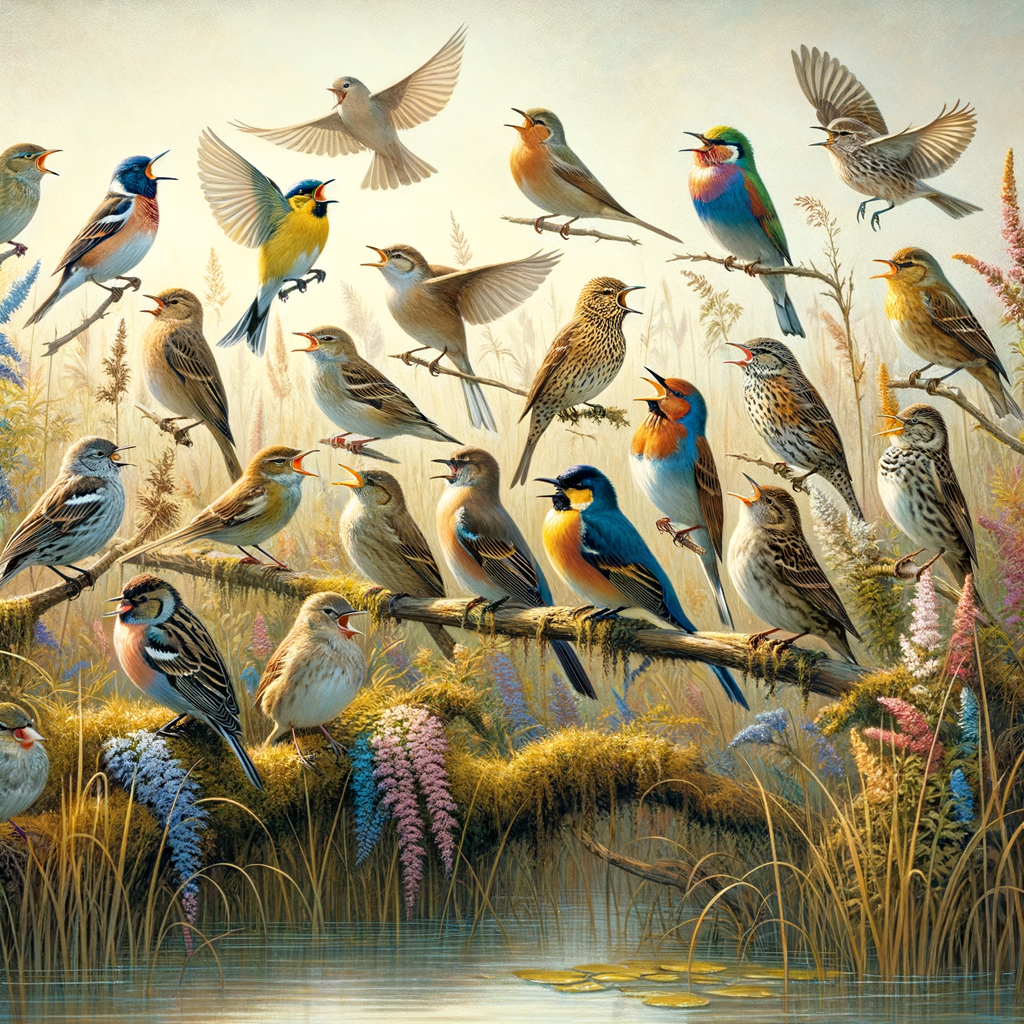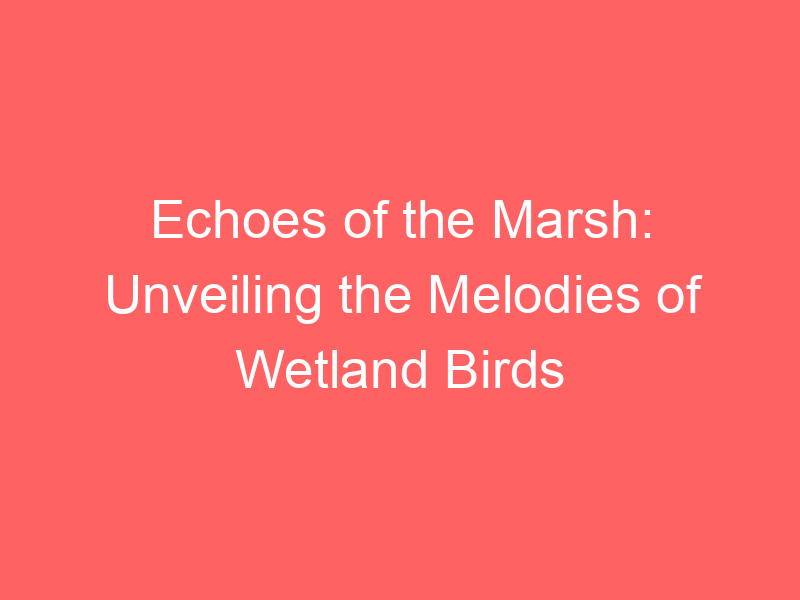
Introduction to Wetland Bird Songs
Wetland bird songs are a symphony of nature that echo across marshlands, creating a serene and vibrant atmosphere. These melodies not only add beauty to the environment but also play a crucial role in the life cycle of various bird species. In this section, we will delve into the importance of these bird songs and provide an overview of different wetland bird species and their unique melodies.
- The Importance of Bird Songs in Marshlands
- Overview of Wetland Bird Species and Their Unique Melodies
Bird songs are more than just pleasant sounds; they serve as a communication tool among birds. In marshlands, these songs are essential for attracting mates, defending territories, and even warning others of potential danger. The rich biodiversity of wetlands is, in part, a result of these complex bird songs.
Wetlands are home to a wide array of bird species, each with its unique melody. Some of the most common wetland birds include the Red-winged Blackbird, whose trills and warbles fill the air, and the Sandhill Crane, known for its loud, rolling call. Other species like the Marsh Wren and the American Bittern also contribute to the wetland’s musical ensemble with their distinctive songs.
Understanding these bird songs can enhance our appreciation for these creatures and their habitats. As we move forward, we will explore more about bird sounds in marshlands, how to identify them, and the joy of birdwatching in these beautiful landscapes.
Understanding Bird Sounds in Marshlands
Marshlands are a symphony of sounds, with each bird species contributing its unique melody. Understanding these bird sounds can be a fascinating and rewarding experience. Let’s delve into how to identify different bird calls and the common bird sounds you can expect to hear in marshlands.
- How to Identify Different Bird Calls
Identifying bird calls is a skill that can be developed over time. Here are some tips to help you get started:
- Listen Carefully: Pay close attention to the pitch, rhythm, and volume of the bird call. Is it high or low? Fast or slow? Loud or soft?
- Observe the Bird: If you can see the bird, take note of its size, color, and behavior. These clues can help you identify the species.
- Use a Field Guide: Field guides can provide detailed information about different bird species and their calls. They often include illustrations and descriptions to help you identify the bird.
- Practice: The more you listen to bird calls, the better you’ll get at identifying them. Try to spend time in different environments to expose yourself to a variety of bird sounds.
- Common Bird Sounds in Marshlands
Marshlands are home to a diverse array of bird species, each with its unique call. Here are some of the most common bird sounds you might hear:
| Bird Species | Sound Description |
|---|---|
| Red-winged Blackbird | A sharp, distinctive ‘conk-la-ree’ sound, often heard at dawn and dusk. |
| Marsh Wren | A rapid, bubbly song that sounds like a tiny typewriter. |
| Great Blue Heron | A deep, hoarse ‘frahnk’ sound, especially when disturbed. |
| Common Yellowthroat | A distinctive ‘witchity-witchity-witchity’ song, often heard in dense vegetation. |
Remember, patience and practice are key when it comes to identifying bird sounds. With time, you’ll be able to recognize the unique melodies of the marshland birds and appreciate the beautiful symphony they create.
Identifying Wetland Bird Songs
Identifying bird songs in the wetlands can be a rewarding and educational experience. It’s a skill that requires patience, keen listening, and a bit of knowledge about the birds you’re likely to encounter. In this section, we will explore the key characteristics of wetland bird calls and how to recognize them.
Key Characteristics of Wetland Bird Calls
Wetland bird calls are as diverse as the species that make them. However, there are a few key characteristics that can help you identify them. These include the pitch, rhythm, and repetition of the song. Wetland birds often have unique calls that are distinct to their species, which makes them easier to identify.
- Recognizing patterns in bird songs
- Identifying unique calls of different wetland bird species
One of the first steps in identifying bird songs is recognizing the patterns. Birds often repeat the same series of notes in a specific order. For example, the Red-winged Blackbird, a common wetland bird, has a distinctive ‘conk-la-ree’ sound that it repeats over and over. By listening for these patterns, you can start to identify different bird species.
Each wetland bird species has a unique call. The American Bittern, for instance, has a low, booming call that sounds like a distant foghorn. On the other hand, the Marsh Wren has a fast, bubbly song that is quite different. By learning these unique calls, you can identify the bird even if you can’t see it.
In the table below, we have listed some common wetland bird species along with a brief description of their calls for your reference.
| Species | Description of Call |
|---|---|
| Red-winged Blackbird | A distinctive ‘conk-la-ree’ sound |
| American Bittern | A low, booming call that sounds like a distant foghorn |
| Marsh Wren | A fast, bubbly song |
Remember, identifying bird songs takes practice. So, don’t be discouraged if you can’t recognize every call at first. With time and patience, you’ll soon be able to identify the melodious songs of the wetland birds.
Wetland Bird Species and Their Melodies
Wetlands are home to a vast array of bird species, each with their unique melodies. These songs not only add to the beauty of these habitats, but also serve as a means of communication among birds. Let’s delve into the world of marshland bird species and their enchanting melodies.
Marshland Bird Species
Marshlands, a type of wetland, are rich in birdlife. These areas are teeming with different bird species, each with a unique song that sets them apart. Here are some common marshland bird species and their songs:
- Red-winged Blackbird: Known for its distinctive “o-ka-leeee” song, the Red-winged Blackbird is a common sight in North American marshlands.
- Marsh Wren: This small bird has a complex and loud song that often includes a series of bubbly notes and trills.
- Common Reed Bunting: Native to Europe and Asia, this bird’s song is a simple, repetitive “zrip-zrip-zrrrrrrrrr”.
- Great Blue Heron: While not known for a melodious song, the Great Blue Heron makes a distinctive “frawnk” sound, especially when disturbed.
Now, let’s explore some unique characteristics of marshland bird melodies:
- Variety: Marshland birds have a wide range of songs, from simple calls to complex melodies. This variety is a reflection of the diversity of bird species in these habitats.
- Function: Bird songs in marshlands serve various purposes, including attracting mates, defending territory, and communicating with other birds.
- Seasonality: Many marshland birds are more vocal during the breeding season, which is typically in the spring and early summer.
- Time of Day: Some marshland birds are most vocal at dawn or dusk, while others sing throughout the day.
Understanding these bird songs can enhance your birdwatching experience and deepen your appreciation for these remarkable creatures and their habitats.
Birdwatching in Marshlands
Marshlands are a paradise for birdwatchers. They are home to a variety of bird species, each with their unique songs and melodies. Birdwatching in these wetlands can be a thrilling experience, especially if you know the right tips and tricks.
Tips for Birdwatching in Marshlands
Here are some useful tips to enhance your birdwatching experience in marshlands:
- Best times for birdwatching in marshlands
- Identifying bird species by their songs
The best times for birdwatching in marshlands are early in the morning and late in the afternoon. During these times, birds are most active, feeding, and singing. According to a study, bird activity peaks at dawn and dusk. So, make sure to set your alarm clock early or reserve your evening for this exciting activity.
Each bird species has a unique song. Learning to identify them by their songs can make your birdwatching experience more rewarding. Start by familiarizing yourself with the songs of common marshland birds. You can use bird song identification apps or guides to help you. Remember, practice makes perfect. The more you listen, the better you’ll get at identifying bird songs.
In conclusion, birdwatching in marshlands can be a delightful experience if you know when to go and how to identify different bird species by their songs. So, grab your binoculars, put on your birdwatching gear, and head to the marshlands for an unforgettable birdwatching experience.
Case Studies: Birdsong in Wetlands
Let’s dive deeper into the world of wetland bird songs by examining two fascinating case studies. These studies will help us understand the intricate relationship between birds, their songs, and the wetland environment.
- Case Study 1: Tracking the Melodies of a Specific Wetland Bird Species
- Case Study 2: The Impact of Environmental Changes on Bird Songs in Marshlands
In this study, scientists focused on a specific bird species known for its unique melody – the Marsh Warbler. Using advanced audio recording equipment, they tracked the bird’s song over a period of one year.
The results were astonishing. The Marsh Warbler’s song changed with the seasons, suggesting that these birds use their songs not just for communication, but also to adapt to their environment. This study highlights the complexity of bird songs and their importance in the life of wetland birds.
This study examined how environmental changes, such as temperature fluctuations and water levels, affect the songs of marshland birds. The study focused on the Red-winged Blackbird, a common marshland bird.
Scientists found that as temperatures rose, the birds’ songs became shorter and less complex. Similarly, when water levels were low, the birds sang less frequently. This study shows that bird songs are not just beautiful sounds, but also crucial indicators of environmental changes.
These case studies show us the intricate relationship between birds, their songs, and the wetland environment. They remind us of the importance of preserving these habitats, not just for the birds, but for the overall health of our planet.
Conclusion: The Melodies of Marshland Birds
As we draw our exploration of marshland birds and their enchanting melodies to a close, it’s important to reflect on what we’ve learned and the significance of these natural symphonies.
- Recap of the importance and diversity of bird songs in wetlands:
- Final thoughts on birdwatching and identifying bird songs in marshlands:
Bird songs are more than just pleasant sounds; they are a vital part of the wetland ecosystem. These melodies serve as a communication tool among birds, enabling them to express emotions, mark territories, and attract mates. The diversity of bird songs in marshlands is a testament to the rich variety of bird species that inhabit these areas. From the deep, resonating calls of the Great Blue Heron to the high-pitched trills of the Marsh Wren, each bird contributes its unique note to the wetland’s chorus.
Birdwatching in marshlands is a rewarding experience that offers a unique opportunity to witness the beauty and diversity of bird species and their songs. Identifying bird songs is a skill that can enhance this experience, allowing you to understand and appreciate the birds on a deeper level. It’s like learning a new language – one that connects you directly to nature. So, the next time you find yourself in a marshland, take a moment to listen to the birds. You’ll be amazed at what you can learn from their melodies.
In conclusion, the melodies of marshland birds are a beautiful and important part of our natural world. They add a touch of magic to the marshlands, creating a symphony that is as diverse and vibrant as the birds themselves. So, let’s continue to appreciate, protect, and learn from these wonderful creatures and their enchanting songs.






